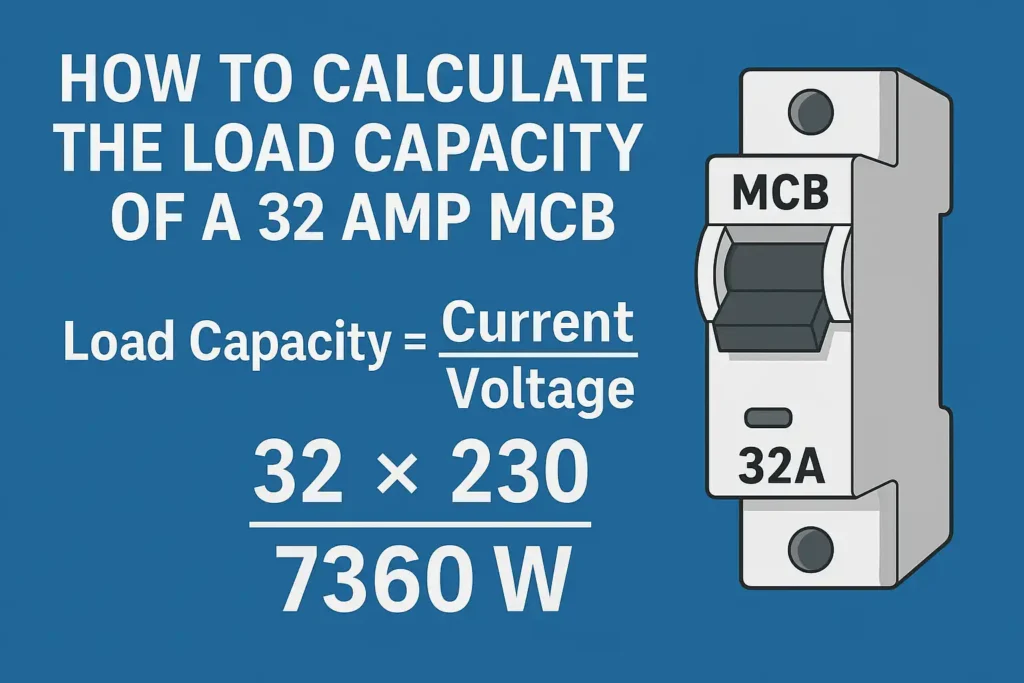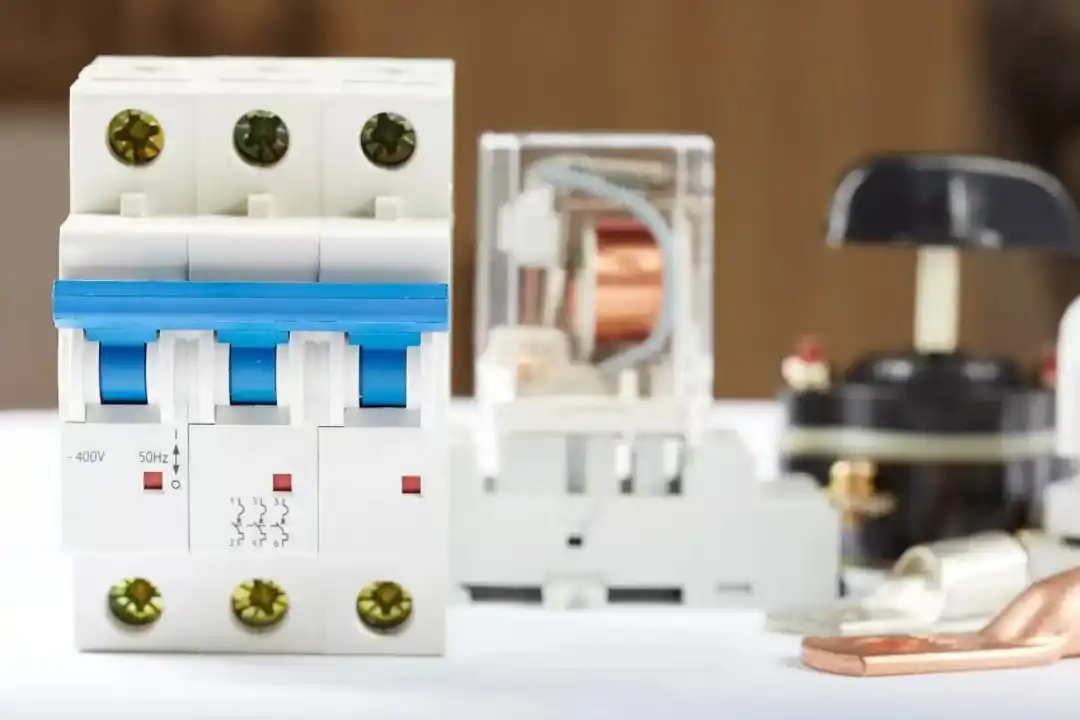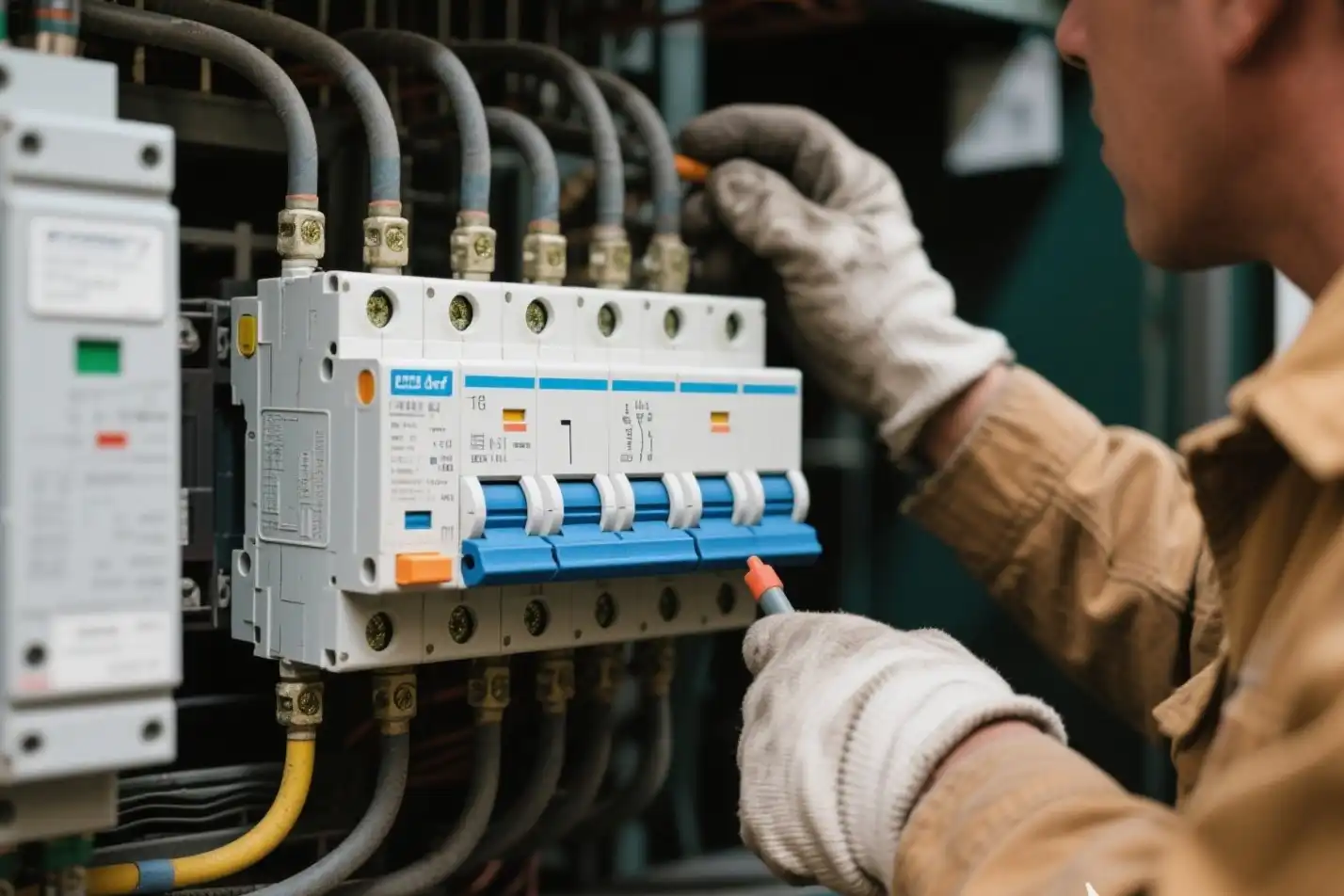A 32 amp MCB, or small circuit breaker, has a load capacity of 32 amps. This means it supports up to 7,680 watts on a 240-volt system. It’s important to know how to calculate this to keep your electrical system safe. If a circuit breaker is overloaded beyond its load capacity, it might trip or cause a fire.
For instance, most home circuits only handle 15 amps. Big appliances like air conditioners or ovens need their own circuits to avoid exceeding the load capacity of the breaker. Knowing how current, voltage, and load work together keeps circuits safe and efficient.
Key Takeaways
-
A 32 amp MCB can support up to 7,680 watts on a 240-volt system. Always check the load to prevent overloading.
-
Use this formula: Load (Watts) = Current (Amps) x Voltage (Volts). This helps you find the circuit’s maximum load.
-
For safety, use only 80% of the MCB’s capacity for constant loads. For a 32 amp MCB, this means safely using 25.6 amps.
-
Think about the type of load (resistive, inductive, or capacitive) when picking an MCB. Different loads affect how it works.
-
Check your MCB and circuit often. Watch for overload signs like tripping or getting too hot.
Understanding the Load Capacity of a 32 Amp MCB
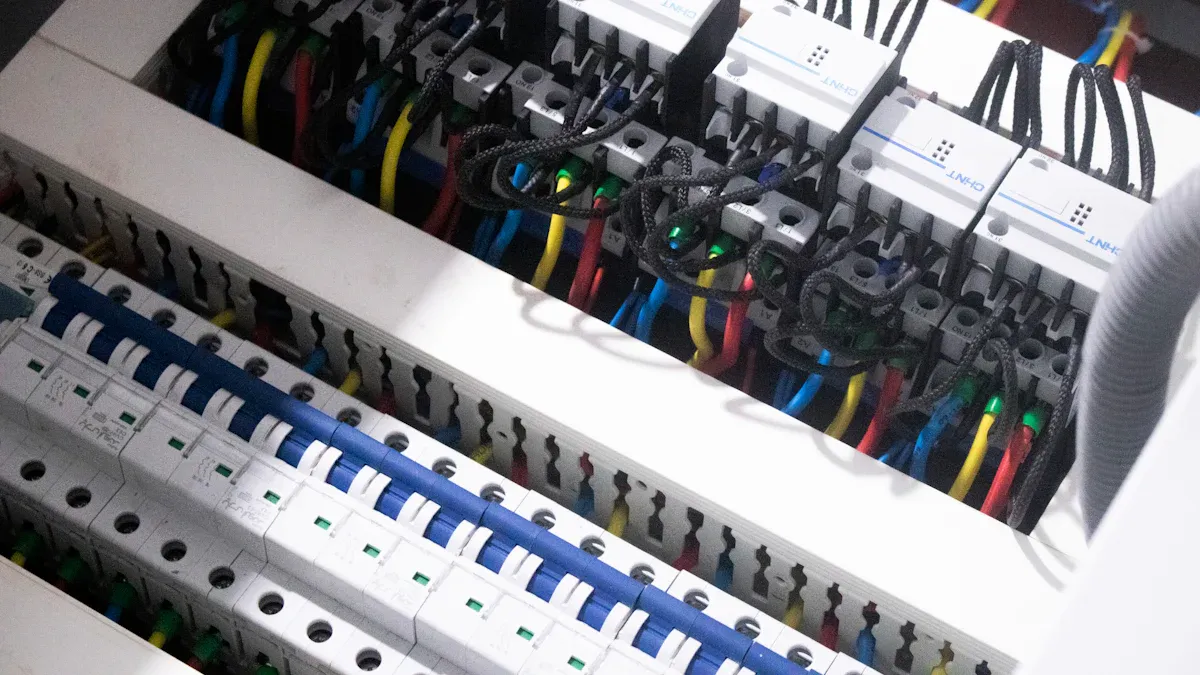
What does the 32 Amp rating mean?
The 32 amp rating shows the most current the MCB can handle safely. This means it protects your system from too much current or short circuits. The IEC 60898-1 standards set this limit to keep the breaker working safely. For example, a 32 amp MCB can handle up to 32 amps under normal use.
|
Aspect |
Details |
|---|---|
|
Rated Current |
The highest current the breaker can handle safely. |
|
Common Ratings |
Includes 1 A, 2 A, 4 A, 6 A, 10 A, 13 A, 16 A, 20 A, 25 A, 32 A, etc. |
|
Tripping Current |
The current level that makes the breaker trip instantly. |
A 32 amp MCB works well for circuits with up to 22 amps. This leaves extra room to avoid overheating or damage. It is great for devices like air conditioners, ovens, or EV chargers.
How to calculate load capacity in watts (e.g., 32A x 240V = 7,680W)
To find the load capacity of a 32 amp MCB, multiply its current by the circuit voltage. For single-phase systems, use this formula:
Load Capacity (Watts) = Current (Amperes) x Voltage (Volts)
For a 32 amp MCB on a 240-volt circuit:
Load Capacity = 32A x 240V = 7,680W
This means the breaker can handle up to 7,680 watts. For three-phase systems, the formula changes slightly:
Load Capacity (Watts) = √3 x Voltage (Volts) x Current (Amperes)
For a 32 amp MCB on a 415-volt three-phase circuit:
Load Capacity = √3 x 415V x 32A ≈ 22,800W
These formulas help you know the maximum load your circuit can handle. Always keep the total wattage of devices below this limit to stay safe.
|
System Type |
Voltage (V) |
Current (A) |
Power (W) |
|---|---|---|---|
|
Single-Phase |
230 |
32 |
7,360 |
|
Three-Phase |
415 |
32 |
≈22,800 |
Why knowing the load capacity is critical for safety
Knowing the load capacity of your 32 amp MCB keeps your system safe and efficient. Circuit breakers stop power when the current gets too high. If you don’t calculate the load correctly, problems can happen:
-
Overloaded circuits can overheat, damaging devices or causing fires.
-
Wrong-sized breakers may trip often, cutting off your power.
-
Using the wrong breaker can harm your wiring and devices over time.
Tip: Always calculate loads carefully for high-power devices like EV chargers. Picking the right breaker size improves safety, saves money, and avoids repairs.
By understanding load capacity, you can avoid these issues. Always leave extra room for sudden power spikes or high-demand devices.
Factors That Affect the Electrical Load Capacity of a 32 Amp MCB
Types of electrical loads (resistive, inductive, or capacitive)
The kind of load on your circuit affects how a 32 amp MCB works. Loads are grouped into resistive, inductive, or capacitive types.
-
Resistive loads include things like heaters and light bulbs. These use steady current, making them easy for the breaker to manage.
-
Inductive loads, like motors and transformers, create magnetic fields. They can cause sudden current spikes, which might trip the breaker.
-
Capacitive loads, such as capacitor banks, store and release energy. These can also cause current changes, affecting the breaker’s performance.
Knowing the load type helps you decide if the MCB’s rating is enough. For inductive or capacitive loads, you might need a breaker with a higher capacity to handle current spikes.
Voltage level and its effect on load capacity
The voltage in your circuit changes how much power a 32 amp MCB can handle. Higher voltage means more power without raising the current. For example, a 240-volt system supports 7,680 watts, while a 415-volt system handles about 22,800 watts.
But voltage changes can cause problems. High Total Harmonic Distortion (THD) can make motors and transformers less efficient. This can lead to overheating and unnecessary breaker trips. Keeping voltage stable helps the breaker work properly.
Tip: Check your system’s voltage and THD often to avoid problems with the MCB.
Circuit length, wire size, and their importance in load calculation
The circuit’s length and wire size affect the load capacity of a 32 amp MCB. Longer circuits lose more voltage, lowering efficiency. To fix this, use wires with the right thickness based on the circuit’s length and load.
|
Aspect |
Details |
|---|---|
|
Wire Sizing Reference |
Use NEC charts to pick the right wire size for load and voltage. |
|
Material Consideration |
Copper and aluminum wires have different ampacity ratings. |
|
Continuous Load Calculation |
Example: 16A * 1.25 = 20A for continuous loads. |
|
Voltage Drop Limitation |
Voltage drop should stay under 3% for feeders and branch circuits combined. |
|
Sizing Based on Conditions |
Use NEC tables to choose wire size based on environment. |
Choosing the right wire size helps the MCB handle the load safely. Always check wire sizing charts and think about material and conditions when planning your circuit.
Ambient temperature and derating considerations
The temperature around your MCB affects how it works. Hotter temperatures can lower its ability to handle electricity. Companies provide charts to adjust the MCB’s capacity for different temperatures. For example, if it’s hotter than 40°C, the MCB may need to handle less power to stay safe.
To adjust for heat, check the manufacturer’s guide. Find the derating factor for your area’s temperature. Multiply this factor by the MCB’s original capacity. For example, if the factor is 0.9 and the MCB is 32 amps, the new capacity is:
Adjusted Capacity = Original Capacity x Derating Factor
Adjusted Capacity = 32A x 0.9 = 28.8A
Where you place the MCB also matters. Keep it in a cool, airy spot to avoid heat problems. Don’t install it near hot items like stoves or heaters.
Tip: Check the temperature around your MCB often. This helps prevent trips and keeps it working well.
Safety margins and continuous vs. short-term loads
Safety margins help protect your system from too much load. Use only 80% of the MCB’s capacity for devices that run all the time. For a 32-amp MCB, this means:
Safe Continuous Load = Rated Capacity x 0.8
Safe Continuous Load = 32A x 0.8 = 25.6A
Devices like fridges or air conditioners run for long periods. These are called continuous loads. Short-term loads, like drills, use power for a short time. These can cause quick spikes in current. While MCBs can handle these spikes, too many can wear them out.
To handle short-term loads, separate high-power devices onto different circuits. This avoids overloading one MCB and reduces tripping risks. Always check the total load before adding more devices.
Note: If your MCB trips a lot, your circuit might be overloaded. You may need a stronger MCB or to move devices to other circuits.
Step-by-Step Guide to Calculate MCB Size and Load Capacity
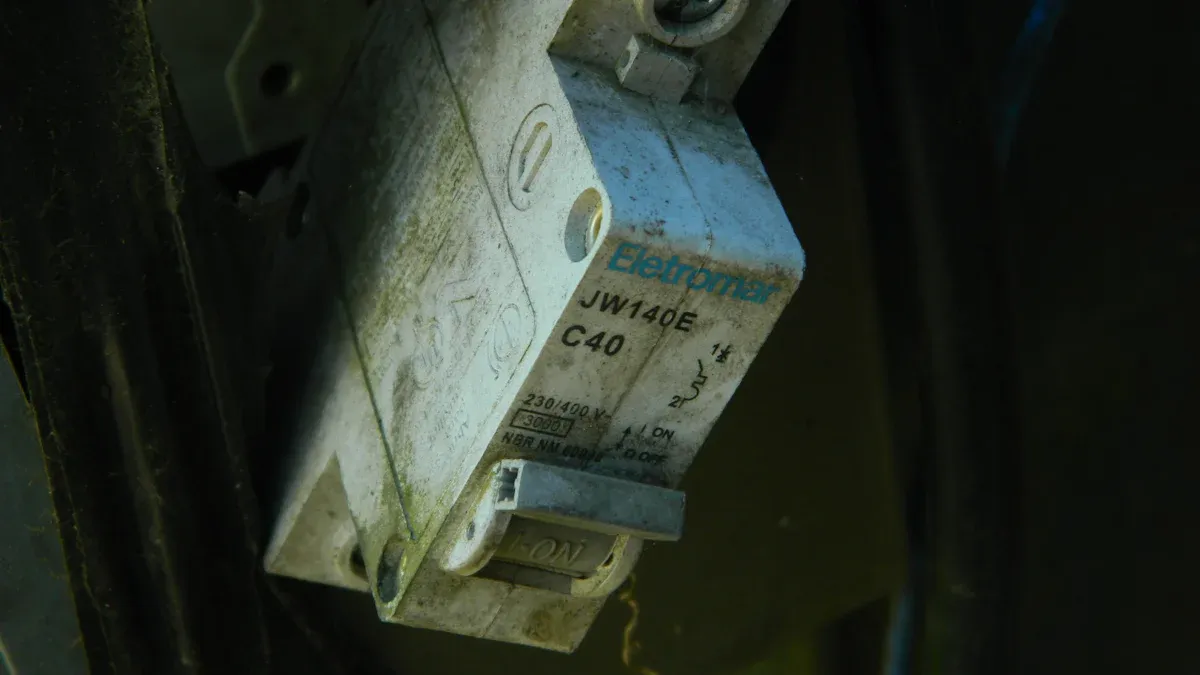
How to find load capacity for single-phase circuits
To figure out the load capacity of a single-phase circuit, you need two things: the MCB’s current rating and the circuit’s voltage. Use this formula:
Load Capacity (Watts) = Current (Amperes) x Voltage (Volts)
For example, if your circuit has a 32 amp MCB and runs at 240 volts, the calculation is:
Load Capacity = 32A x 240V = 7,680W
This means the circuit can handle up to 7,680 watts. But for safety, only use 80% of the MCB’s capacity for continuous loads. For a 32 amp MCB, the safe load is:
Safe Continuous Load = 32A x 0.8 = 25.6A
In watts, this becomes:
Safe Continuous Load (Watts) = 25.6A x 240V = 6,144W
Keep your devices’ total wattage below this limit to avoid overloading.
Tip: Use the right wire size to prevent voltage drops and ensure smooth operation.
How to find load capacity for three-phase circuits
For three-phase circuits, the formula changes slightly. Multiply the voltage by the square root of 3 (about 1.732), then multiply by the current. The formula is:
Load Capacity (Watts) = √3 x Voltage (Volts) x Current (Amperes)
For example, if you have a 32 amp MCB on a 415-volt three-phase circuit, the calculation is:
Load Capacity = √3 x 415V x 32A ≈ 22,980W
This means the circuit can handle about 22,980 watts. For continuous loads, apply the 80% rule:
Safe Continuous Load = 32A x 0.8 = 25.6A
Safe Continuous Load (Watts) = √3 x 415V x 25.6A ≈ 18,384W
Three-phase circuits are great for high-power equipment like industrial machines or large HVAC systems. They spread power evenly, reducing overload risks.
Note: Make sure the breaker size matches the load and fault levels. Choose a breaker with a breaking capacity higher than the fault current.
Example: Calculating load for a single-phase circuit
Let’s say you need to pick a breaker for a circuit running a 5,000-watt air conditioner. The circuit operates at 240 volts. First, calculate the load current:
Load Current (Amperes) = Power (Watts) ÷ Voltage (Volts)
Load Current = 5,000W ÷ 240V = 20.83A
Next, choose an MCB with a rating higher than the load current. Since the load is 20.83A, a 25A MCB works. Check that the continuous load stays under 80% of the MCB’s capacity:
Safe Continuous Load = 25A x 0.8 = 20A
Here, the air conditioner’s load (20.83A) is slightly above the safe limit. Upgrade to a 32 amp MCB for better protection. At 240 volts, its load capacity is:
Load Capacity = 32A x 240V = 7,680W
This ensures the circuit can safely handle the air conditioner, even during peak use.
Tip: Always consult a licensed electrician to confirm your calculations and follow local electrical codes.
Practical example: Load calculation for a three-phase circuit
When working out the load for a three-phase circuit, you need to think about current, voltage, and the type of load. Let’s go through an example to make this clearer.
Step-by-Step Calculation Example:
-
Find the Neutral Current (In):
For a wye-connected load, add the currents from all phases. For example:In = Ia + Ib + Ic In = 10A + 12A + 15A = 37A -
Work Out the Total Apparent Power (S):
Add the apparent power from each phase:S = Sa + Sb + Sc S = 4000 VA + 4980 VA + 5700 VA = 14680 VA -
Check the Circuit Breaker Rating:
Make sure the circuit breaker (MCB) can handle the load. For a three-phase system, use this formula:Load Capacity (Watts) = √3 x Voltage (Volts) x Current (Amperes)For a 32 amp MCB on a 415-volt circuit:
Load Capacity = √3 x 415V x 32A ≈ 22,980WCompare this capacity with the total apparent power (S). If the load is higher than the MCB’s capacity, you’ll need a stronger breaker.
Real-World Testing Factors:
When calculating loads, consider these key factors:
|
Parameter |
What It Means |
|---|---|
|
Lmax |
Longest circuit length in meters |
|
Isc |
Short-circuit current (phase-to-phase) |
|
U |
Nominal voltage between phases |
|
Im |
Magnetic trip setting of the breaker |
|
ρ |
Wire material resistivity at average temperature |
These factors help ensure safe and accurate circuit planning. Always ask a licensed electrician for help with tricky setups.
Tip: For industrial circuits, use tools like clamp meters to check current and voltage before choosing an MCB.
Adjusting for inrush current and peak loads
Inrush current and peak loads can affect how well your MCB works. These spikes happen when devices like motors or LED drivers start up, pulling more current than usual. Knowing how to adjust for these helps keep your circuit safe.
Key Things About Inrush Current:
-
Duration: How long the spike lasts affects the MCB’s response.
-
Peak Current: Higher peaks need breakers with stronger magnetic trip settings.
-
Waveform Shape: The current’s shape changes how the MCB reacts.
Formula for LED Driver Connections:
To find out how many LED drivers can connect to an MCB, use this formula:
Min(Itrip / Idriver, Ihold / Iinrush)
Where:
-
Itrip is the MCB’s tripping current.
-
Idriver is the LED driver’s steady current.
-
Ihold is the MCB’s holding current.
-
Iinrush is the LED driver’s peak inrush current.
Steps to Adjust:
-
Measure Inrush Current: Use a multimeter or clamp meter to check the peak current when the device starts.
-
Pick the Right MCB: Choose a breaker with a magnetic trip setting higher than the inrush current.
-
Spread High-Inrush Devices: Don’t put too many high-inrush devices on one circuit. This lowers the chance of tripping.
Note: Devices like fridges and air conditioners often have high inrush currents. Plan circuits carefully to avoid overloads.
By considering inrush current and peak loads, you can design safer circuits and make your MCB last longer. Always leave extra room for unexpected spikes.
Continuous vs. Short-Term Loads and Their Impact on MCB Performance
Differences between continuous and short-term loads
Knowing the difference between continuous and short-term loads is important. Continuous loads run for long hours, often over three hours. Examples include fridges, air conditioners, and lights. These need an MCB that can handle steady power without tripping.
Short-term loads work for short times, like drills or blenders. These cause quick power spikes but don’t use high power for long. When planning circuits, consider these differences to keep your MCB working well.
How inrush current affects MCB performance
Inrush current happens when devices like motors start up. This is a sudden power surge, much higher than normal use. For example, a motor needs extra power to start moving. This spike can trip the MCB, even if the circuit is not overloaded.
Over time, inrush current can wear out the MCB. To avoid this, pick an MCB with a magnetic trip setting. This helps it handle short power bursts without tripping unnecessarily.
Managing high inrush current loads effectively
You can manage high inrush current loads with smart methods. One way is using energy stored in a rectifier’s capacitor. This smooths power demand and reduces strain on the MCB. Another option is adding controlled switches in medium voltage systems. These lower inrush currents when starting transformers, avoiding voltage drops.
For sensitive devices, try a soft-start method. This slowly increases voltage during startup, stopping inrush current. Using these strategies protects your MCB and keeps circuits stable.
Tip: Always ask a licensed electrician for help with high inrush current loads. They can guide you in choosing the right MCB and setup.
When to Upgrade from a 32 Amp MCB
Signs your MCB might be overloaded
An overloaded MCB shows clear signs you shouldn’t ignore. Frequent tripping means the MCB may handle too much current. Overheating is another warning. A hot breaker or burning smell near the panel shows trouble.
Flickering lights or weak power in devices can also mean overload. These happen when the MCB can’t handle appliance demand. If you see these signs, check your circuit’s load and think about upgrading.
Picking the right MCB rating for your circuit
Choosing the right MCB keeps your system safe and working well. Add up the total current of all devices on the circuit. For example, if appliances use 40 amps, a 32 amp MCB won’t work. You’ll need a 40A or 50A breaker instead.
Different MCB ratings fit different needs. Homes often use MCBs rated 6A to 32A. Industrial setups may need higher ratings. The table below compares MCBs and MCCBs for better choices:
|
Characteristic |
MCB |
MCCB |
|---|---|---|
|
Rated Current |
6 – 125A |
0.5 – 160A |
|
SC Breaking Capacity |
<25kA |
<50kA |
|
Rated Voltage |
400V |
440V, 500V, 690V |
|
Impulse Voltage |
4kV |
6kV – 8kV |
|
Pollution Degree |
2 |
3 |
|
Curves |
B, C, D |
B, C, D, K, Z, MA |
For homes, MCBs are best. For industrial circuits, MCCBs handle higher loads. Always match the breaker size to your circuit’s needs.
Safety tips for upgrading an MCB
Upgrading an MCB needs careful planning for safety. First, ask a licensed electrician to check your circuit. They can tell if your breaker is too small or if other problems exist. Turn off the main power before replacing the MCB to avoid shocks.
Pick a new breaker that meets safety rules and fits your circuit’s needs. For example, only replace a 32 amp MCB with a 40A one if the wires can handle more load. Using the wrong wire size can cause overheating or fires.
Different uses need special safety steps. For homes, focus on reliable protection to stop overloads. In businesses or factories, pick breakers that meet safety rules and improve operations. The table below shows safety needs for different places:
|
Application Segment |
Key Drivers |
Importance for Safety |
|---|---|---|
|
Residential |
New housing, smart homes |
Reliable circuit protection |
|
Commercial |
Infrastructure growth, energy efficiency |
Operational continuity and safety compliance |
|
Industrial |
High-current operations, automation |
Equipment protection and production efficiency |
|
Healthcare |
Medical equipment protection |
Continuous power for life-saving operations |
|
Data Centers |
Uninterrupted power needs |
Protection against faults and data loss |
Follow these tips to upgrade your MCB safely and keep your system running well.
Knowing the load capacity of a 32 amp MCB is key to keeping your electrical system safe. Correct calculations help circuits work well without being overloaded. Things like voltage, wire thickness, and temperature affect how the MCB performs. For instance, single-pole MCBs with 6 or 10 amps can handle up to 2,000 watts. These protect circuits from getting too much current or short circuits.
|
MCB Type |
Rating (Amps) |
Load Capacity (Watts) |
Purpose |
|---|---|---|---|
|
Single-Pole |
6 or 10 |
Up to 2000 |
Stops overloads and short circuits |
|
Multi-Pole |
6 or 10 |
Up to 2000 |
Protects circuits from too much current |
Real-life examples show why using the right MCB matters. In Jakarta, better MCB setups cut maintenance team travel time by 32%. This improved safety and saved time. Always ask a licensed electrician for tricky situations to follow safety rules.
Tip: Check your MCBs and circuits often to avoid dangers.
FAQ
What does an MCB do in a circuit?
An MCB stops electricity flow when the current gets too high. It prevents overheating, short circuits, and fires. This keeps your electrical system safe and working well.
Can a 32 amp MCB handle all types of loads?
No, it cannot. Different loads—like resistive, inductive, or capacitive—affect how an MCB works. For example, motors (inductive loads) may need a stronger MCB for power spikes.
How do you find the safe load for a 32 amp MCB?
Multiply the MCB’s rating by 0.8 to find the safe load. For a 32 amp MCB, the safe load is 25.6 amps. This avoids frequent tripping and keeps the breaker within limits.
Why does an MCB trip often?
Frequent trips mean the circuit is overloaded or has a fault. Check if the total load is too high for the MCB. If the problem continues, ask an electrician to check the wiring and devices.
When should you replace a 32 amp MCB?
Replace it if the circuit often exceeds the MCB’s limit or you add big devices. Make sure the new MCB fits the circuit’s load and wire size for safety.
The following information may be of interest to you
The difference between AC MCB and DC MCB
The difference between MCCB and MCB
How many watts can a 20 ampere circuit breaker handle

